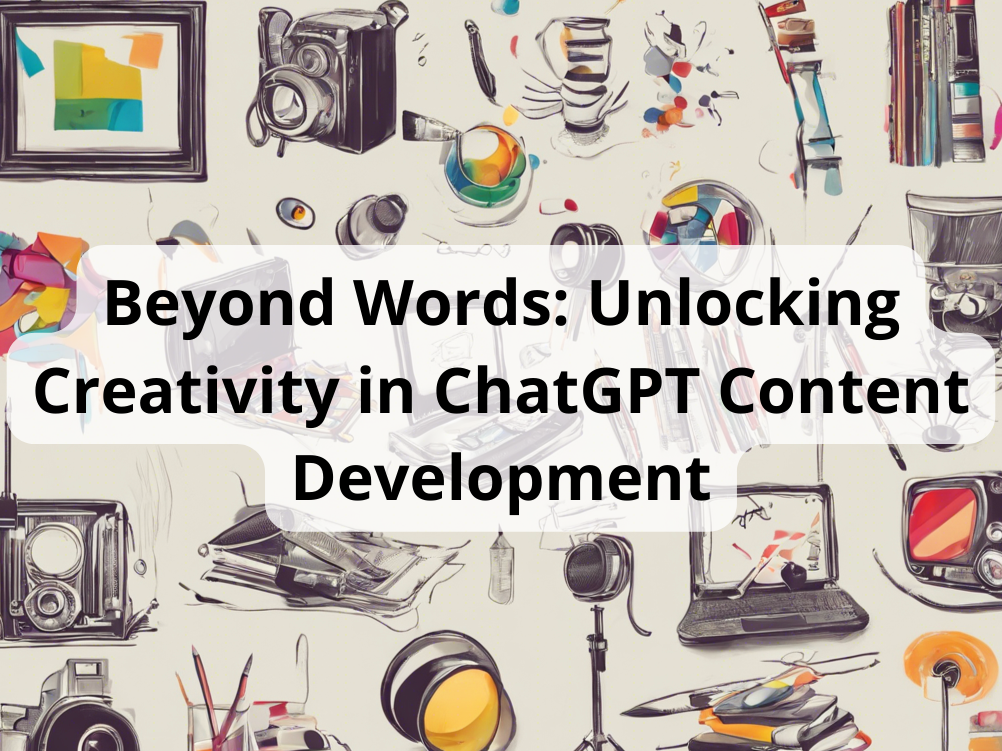
When used effectively, creativity promotes learner engagement, motivation, critical thinking, and problem-solving. Not only does it enhance the learning experience, but fosters knowledge retention, and allows for personalized and differentiated instruction.
By harnessing creativity as a course creator, you can create impactful and memorable educational experiences that empower learners to succeed in their learning journey.
How can you add creativity to your online courses? A great way is using ChatGPT – the AI tool that is revolutionizing content development. Or use LearnWorlds AI Assistant for Online Courses.
Powered by the state-of-the-art GPT-3.5 architecture developed by OpenAI, ChatGPT is a cutting-edge language model designed to assist creators in generating high-quality, creative, and personalized content.
Since the release of ChatGPT, creators of any field, have been experimenting with it, trying to discover its power and utilize its capabilities to the max. Its potential is huge, and it has already proven it.
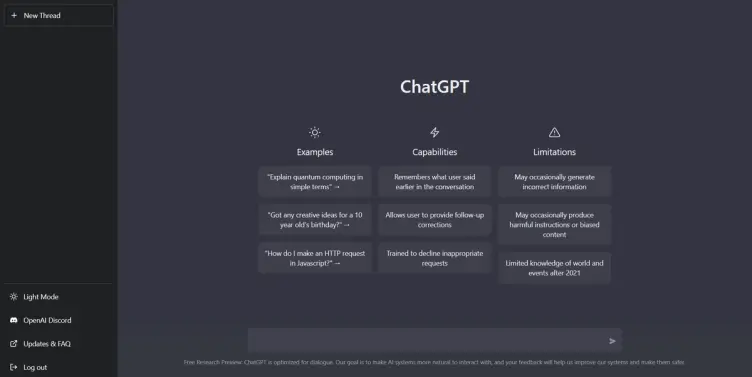
Content creation as we know it will never be the same, but that’s OK because it simply doesn’t have to be. When your mind goes blank, or you run out of ideas on what learning activities you can create, you know you can always rely on AI for help.
As technology is evolving, it’s essential to keep up with it. Learning how to use ChatGPT as your go-to private tech-savvy assistant can only make your job easier.
What’s only important to remember if you are only considering using it, is that AI will not replace you, but a person using AI will. So, if you want to beat the competition and become the best in your industry, it’s time to learn its ways.
Oxford Languages dictionary defines creativity as ‘the use of imagination or original ideas to create something; inventiveness’. As a term is often difficult to interpret or put into context, but it becomes easier to understand its role when examining its impact on online learning.
As mentioned earlier, there are several advantages of incorporating creativity into your online courses. Let’s explore these further:
Creative content captures learners’ attention and keeps them engaged throughout the course. Innovative and imaginative elements, such as interactive exercises, multimedia presentations, and compelling narratives, make the learning experience enjoyable and stimulating. This increased engagement fosters motivation, leading to better knowledge retention and a higher likelihood of course completion.
Creative approaches in content development enable course creators to present information in unique and relatable ways. By incorporating real-life examples, case studies, and practical applications, learners can connect the course material to their own lives and experiences. This connection enhances understanding, promotes critical thinking, and facilitates the application of knowledge in real-world scenarios.
Creativity encourages learners to think outside the box and explore alternative perspectives. It nurtures their problem-solving skills and stimulates critical thinking abilities, and may lead to more meaningful discussions. By presenting challenges, posing thought-provoking questions, and encouraging learners to find innovative solutions, online courses foster the growth of valuable cognitive skills that are applicable beyond the course material.
Creativity allows course creators to tailor content to diverse learner needs, preferences, and learning styles. By incorporating varied instructional approaches, interactive elements, and customization options, online courses can accommodate different learning paces, aptitudes, and interests. This personalization enhances the overall learning experience, making it more meaningful and effective for individual learners.
Creative content development strategies, such as storytelling, gamification, and visual aids, facilitate better information retention. Learners are more likely to remember and apply knowledge gained from courses that are presented in innovative and engaging ways. By stimulating multiple senses and employing interactive elements, creativity strengthens memory encoding and retrieval processes, ensuring long-term knowledge retention.
In the increasingly crowded online education market, creativity can help courses stand out from the competition. By offering unique and captivating learning experiences, courses can attract and retain learners who seek engaging and innovative approaches to education. Creativity in online courses becomes a key differentiator, giving course creators a competitive edge in a rapidly evolving industry.
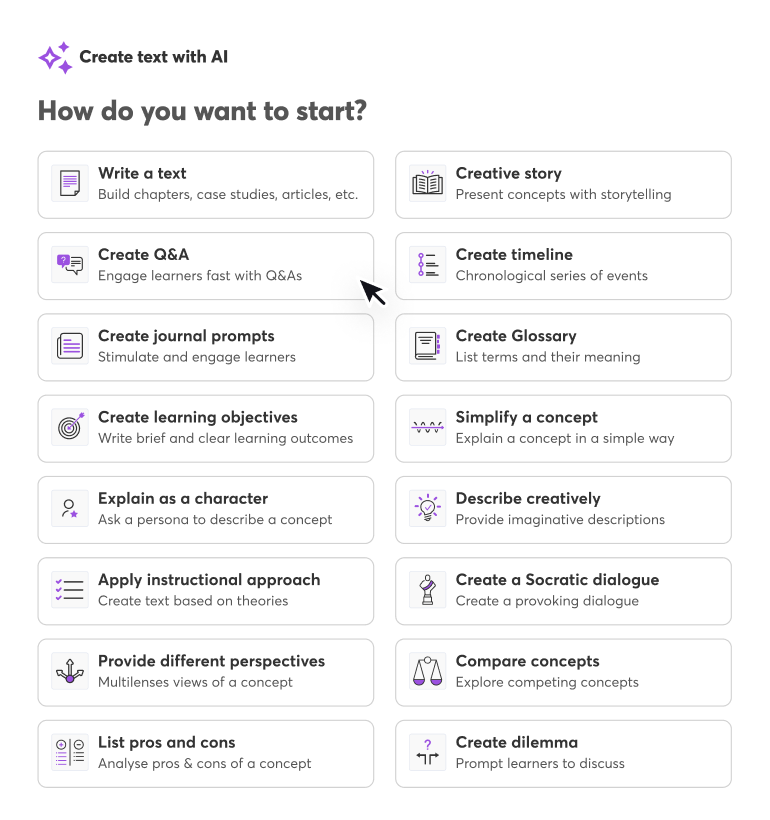
Creativity plays a vital role in online course content, and it’s an element that needs to be included in the learning process. Giving learners the opportunity to be creative means encouraging them to solve problems and communicate ideas in original and rather surprising ways.
When used effectively, creativity promotes learner engagement, motivation, critical thinking, and problem-solving. Not only does it enhance the learning experience, but fosters knowledge retention, and allows for personalized and differentiated instruction.
Discover the LearnWorlds AI experience
Explore LearnWorlds AI
AI-CTA-for-Trials-3.1.png
By harnessing creativity as a course creator, you can create impactful and memorable educational experiences that empower learners to succeed in their learning journey.
How can you add creativity to your online courses? A great way is using ChatGPT – the AI tool that is revolutionizing content development. Or use LearnWorlds AI Assistant for Online Courses.
Powered by the state-of-the-art GPT-3.5 architecture developed by OpenAI, ChatGPT is a cutting-edge language model designed to assist creators in generating high-quality, creative, and personalized content.
Since the release of ChatGPT, creators of any field, have been experimenting with it, trying to discover its power and utilize its capabilities to the max. Its potential is huge, and it has already proven it.
ChatGPT’s online environment (Image Source: LinkedIn)
Content creation as we know it will never be the same, but that’s OK because it simply doesn’t have to be. When your mind goes blank, or you run out of ideas on what learning activities you can create, you know you can always rely on AI for help.
As technology is evolving, it’s essential to keep up with it. Learning how to use ChatGPT as your go-to private tech-savvy assistant can only make your job easier.
What’s only important to remember if you are only considering using it, is that AI will not replace you, but a person using AI will. So, if you want to beat the competition and become the best in your industry, it’s time to learn its ways.
Oxford Languages dictionary defines creativity as ‘the use of imagination or original ideas to create something; inventiveness’. As a term is often difficult to interpret or put into context, but it becomes easier to understand its role when examining its impact on online learning.
As mentioned earlier, there are several advantages of incorporating creativity into your online courses. Let’s explore these further:
Creative content captures learners’ attention and keeps them engaged throughout the course. Innovative and imaginative elements, such as interactive exercises, multimedia presentations, and compelling narratives, make the learning experience enjoyable and stimulating. This increased engagement fosters motivation, leading to better knowledge retention and a higher likelihood of course completion.
Creative approaches in content development enable course creators to present information in unique and relatable ways. By incorporating real-life examples, case studies, and practical applications, learners can connect the course material to their own lives and experiences. This connection enhances understanding, promotes critical thinking, and facilitates the application of knowledge in real-world scenarios.
Creativity encourages learners to think outside the box and explore alternative perspectives. It nurtures their problem-solving skills and stimulates critical thinking abilities, and may lead to more meaningful discussions. By presenting challenges, posing thought-provoking questions, and encouraging learners to find innovative solutions, online courses foster the growth of valuable cognitive skills that are applicable beyond the course material.
Creativity allows course creators to tailor content to diverse learner needs, preferences, and learning styles. By incorporating varied instructional approaches, interactive elements, and customization options, online courses can accommodate different learning paces, aptitudes, and interests. This personalization enhances the overall learning experience, making it more meaningful and effective for individual learners.
Creative content development strategies, such as storytelling, gamification, and visual aids, facilitate better information retention. Learners are more likely to remember and apply knowledge gained from courses that are presented in innovative and engaging ways. By stimulating multiple senses and employing interactive elements, creativity strengthens memory encoding and retrieval processes, ensuring long-term knowledge retention.
In the increasingly crowded online education market, creativity can help courses stand out from the competition. By offering unique and captivating learning experiences, courses can attract and retain learners who seek engaging and innovative approaches to education. Creativity in online courses becomes a key differentiator, giving course creators a competitive edge in a rapidly evolving industry.
Build Your
AI-Powered Academy!
Explore LearnWorlds AI
AI-CTA-for-Trials-2.png
How Creativity Enhances Learner Engagement and Retention
Creativity can increase learner engagement with the taught material and boost retention because it requires learners to get more actively involved in learning.
Instead of passively going through each piece of content – let’s say a video, reading through an ebook, or viewing presentation slides as the instructor delivers the lesson, getting in the process of becoming more creative presents a unique challenge to them.
Creativity engages learners by:
Capturing their attention
Building emotional connection
Promoting active learning
Creating a multi-sensory experience
Enabling personalization and relevance
Encouraging their novelty and curiosity
Aiding memory encoding and retrieval processes
Bringing in enjoyment and intrinsic motivation
With the element of creativity, learners become active participants in the learning process, forming emotional connections, and finding relevance in the content.
Personalization helps learners connect with the material on a more personal level, allowing them to see the practical application and value of the knowledge being acquired. Also, multi-sensory experiences – that involve using the visual and auditory senses, enrich learning thus making it more immersive and memorable.
Creative content engages learners in interactive and enjoyable experiences and stimulates the learners’ desire to learn, leading to increased effort and perseverance.
The Role οf Creativity in Fostering Critical Thinking and Problem-Solving Skills
Apart from boosting engagement and knowledge retention, creativity helps in the development of critical thinking and problem-solving skills. Its role here is crucial as it helps learners challenge original perceptions and adopt out-of-the-box thinking.
Creativity encourages critical thinking in the following ways:
Encouraging diverse perspectives: creativity prompts learners to question assumptions, challenge existing ideas, and seek innovative ways to solve problems. By embracing diverse perspectives, critical thinking is nurtured, enabling learners to analyze situations from multiple angles.
Promoting open-ended exploration: creative tasks and activities allow open-ended exploration, where learners can experiment, take risks, and think flexibly. This encourages learners to generate multiple ideas, evaluate their viability, and adapt their thinking based on feedback and reflection.
Breaking mental barriers: creativity helps to challenge traditional boundaries and considers unconventional solutions. It helps learners take more risks and embrace ambiguity, empowering them to approach problems with an open mind.
Connecting diverse knowledge: creativity helps learners draw from various domains of knowledge and make connections between different subjects and disciplines. Creative challenges stimulate critical thinking as learners analyze, synthesize, and evaluate information from multiple sources to develop well-rounded solutions.
Stimulating analytical thinking: creativity requires analytical thinking skills, such as identifying patterns, making logical connections, and evaluating information critically. When engaging in creative problem-solving, learners must analyze the problem, break it down into its components, and consider various factors and variables.
By incorporating creativity into the learning process, you can encourage learners to think critically, analyze situations effectively, consider multiple perspectives, and generate innovative solutions.
Creativity encourages learners to embrace complexity and grow key personal qualities like adaptability, and open-mindedness which are essential in life in general.
ChatGPT shows incredible potential in creating and developing creative content. It generates responses that are not limited to human biases, and so it allows for more divergent thinking and exploration of new ideas.
Since it’s impossible to be or feel creative 100 percent of the time, you can use this tool to get through creative blocks and speed up tedious tasks, allowing you to focus on the more important aspects of your work when creating an online course.
Some of ChatGPT’s foundational and most impressive capabilities are:
Idea generation and brainstorming
Offering inspiration and conceptualization
Using personalization and adaptation
Producing innovative content formats
ChatGPT’s creative writing assistance can help you craft engaging narratives, compelling dialogues, and descriptive passages. For example, it can offer suggestions for enhancing the use of language, creating engaging storylines, and developing characters that can be used inside a learning activity.
As a powerful language model, ChatGPT can engage in conversations on a wide range of topics. Its training database is vast and it can provide information, answer questions, offer explanations, and participate in open-ended discussions.
ChatGPT has access to a large amount of general knowledge acquired from the internet, books, and other textual sources up until September 2021. It can provide information on various subjects such as science, history, geography, pop culture, and more.
The tool can understand and interpret complex language structures, including idioms, metaphors, and colloquial expressions. It can parse sentences, analyze the context, and generate relevant and coherent responses.
It can generate creative text, including stories, songs, poetry, jokes, video scripts, and imaginative scenarios. While it can produce interesting and entertaining content, it’s important to remember that the model’s responses are based on patterns and examples it has seen during training and not on personal experiences.
ChatGPT can help with various tasks such as scheduling, providing recommendations, generating ideas, or helping with problem-solving. It can offer suggestions, and step-by-step instructions, or provide relevant information to aid in achieving specific goals.
Its potential for enriching existing content and adding creativity is undeniable as it has shown a remarkable ability to generate creative responses. How creative ChatGPT can get through is highly dependent on the prompts you give it as well.

Note: It’s important to have in mind that creativity is subjective, and the quality and novelty of the responses from ChatGPT can vary. While it can generate creative content, it is not capable of true understanding or generating original ideas beyond what it has learned from its training data.
When using ChatGPT, you can maximize the results you get by using a few tricks and techniques to inspire thought-provoking responses. The more you use these and experiment with the tool, the better you will understand how it works to generate content that aligns with your needs and expectations.
To get the exact response you are looking you will need to learn how to write prompts effectively. Prompt engineering is the starting point as prompts are the stimulus given to ChatGPT to generate responses. These can be statements or questions and work as instructions or as a way to set the discussion topic.
They are clear and specific: a clear and detailed description of the topic/question will give you more targeted responses instead of confusing ones.
They include keywords: add keywords to help the bot stay on topic while generating a response, and producing the content you need.
They use questions: questions are more effective to get more focused responses than statements which may provide more open-ended discussions.
They provide context: include background information or explain the terminology used in your prompt to help the tool understand the topic better.
They are not restrictive: asking very specific or close-ended questions can limit the element of creativity in the responses.
So make sure to keep things in mind when generating content with ChatGPT.
The tone of your voice when writing to ChatGPT can influence the results you get from it. When talking to the chatbot, make sure to use different conversational styles and see the differences between its responses.
For example, you may use formal or informal language, or a more instructional tone as opposed to conversational. And, don’t worry – you won’t hurt its feelings.
You can also instruct the bot to respond in an analogous manner e.g. use a personal tone of voice, encouraging, funny, assertive, witty, compassionate, and the list goes on.
Just like in marketing, storytelling can be used inside educational content to make it more engaging and compelling. With the help of ChatGPT, it is worth trying to get some storytelling elements that can be incorporated into your learning activities or even assessments. A creative narrative will hook your learners right away, and spark their curiosity and motivation, increasing the likelihood of them taking part in the online class.
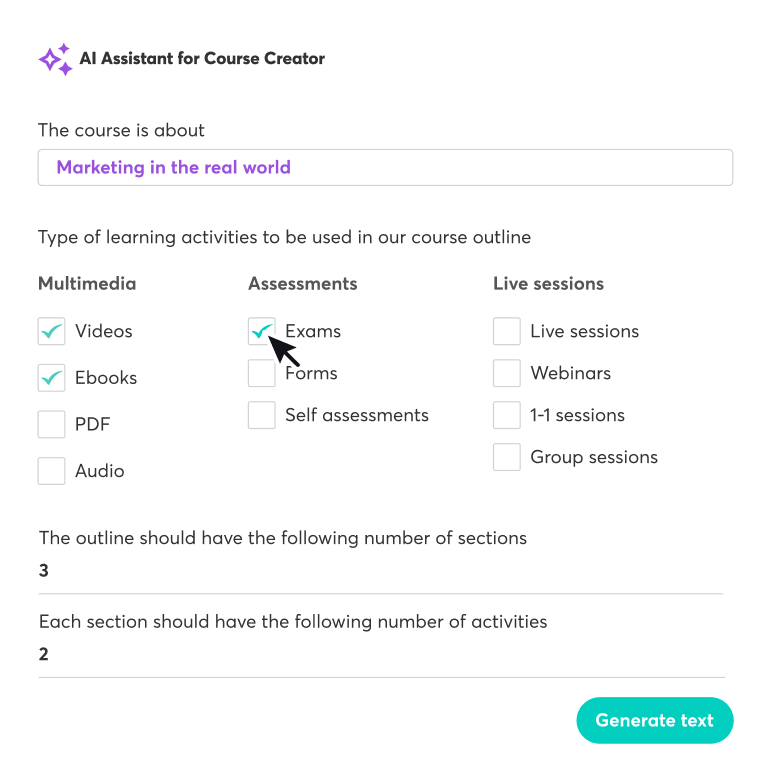
Enhancing Learner Experience with Creative Content
Now there are many ways to exchange your learners’ experience using creative content from ChatGPT. The tool has endless possibilities, but if you are just started using it, it might help you go over some real-life examples and use cases first.
Creating engaging introductions and hooks using ChatGPT
Apart from creating successful online course outlines and lesson plans, you can use ChatGPT to create engaging course introductions and hooks to capture your learners’ attention.
Your course’s introduction sets the scene and prepares your learners for what comes in the next sections, so it’s important to make it as grand and memorable as possible.
Here’s an example of a prompt that instructs ChatGPT to create an introduction and a creative hook for an art course:

The example tells ChatGPT which role to take – artist and what it needs to do in detail.
The prompt can be as descriptive as you want, but it’s good practice to leave some room for imagination to allow the tool to browse and present examples that perhaps you haven’t thought of.
And, here’s the response:
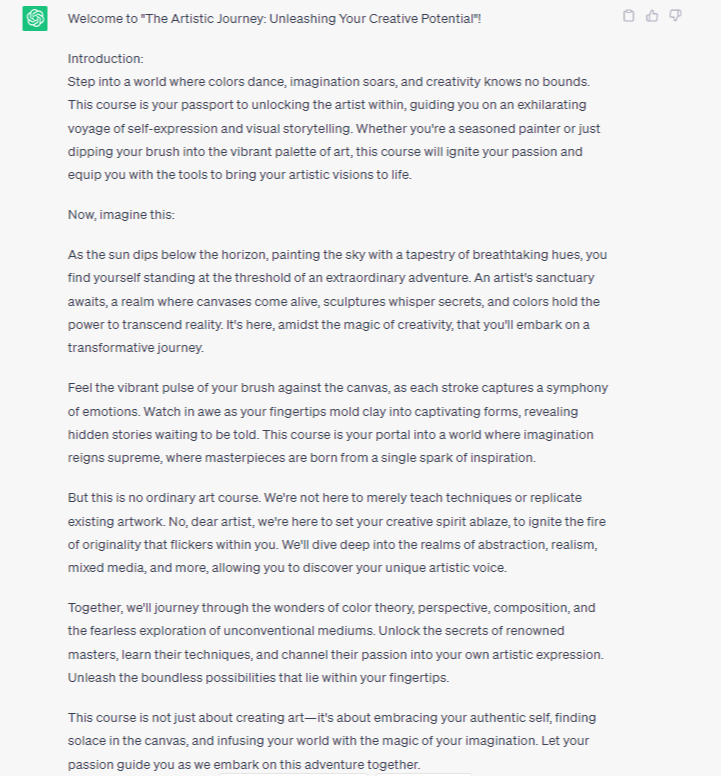
ChatGPT generated a course title along with its response and came up with a creative story to entice learners.
As you can see the answer is quite lengthy. However, you can continue working on it – making your own changes by adding or removing parts of the content or by asking follow-up questions and getting ChatGPT to create a shorter version for you.
Here’s another prompt example, this time for coaching:

This example asks ChatGPT to create an introduction for a coaching course on public speaking that caters to a specific group of people. It also instructs right from the start how long the response should be.
